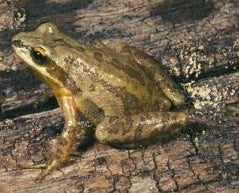SCIENTIFIC NAME:
Pseudacris feriarum feriarum
STATUS:
Common nearly statewide; absent from extreme southern Alabama except along Conecuh and Chattahoochee Rivers, where its distribution barely extends into Florida. Lowest Conservation Concern.
OTHER NAMES:
Older literature lists the upland chorus frog as Pseudacris triseriata with feriarum being a subspecies.
DESCRIPTION:
Upland chorus frogs are a small frog species attaining a maximum length of 1.5 inches. Their color varies from brown to gray with a light line along their upper lip and a dark stripe that begins on the snout, passes through their eye and continues down the side. A dark triangle is usually present between their eyes. Markings on their back usually consist of three dark stripes, partial stripes or dark spots with the undersides being a cream color, often with dark stippling on the chest.
DISTRIBUTION:
Upland chorus frogs are common to abundant in all areas of Alabama down to the southern boundary of the Red Hills regions. In the Lower Coastal Plain they are locally common from the Conecuh River eastward and apparently absent west of the Conecuh River.
HABITAT:
Upland chorus frogs are nocturnal and prefer grassy areas, moist woodlands, river-bottom swamps, ponds, bogs and marshes. Breed in temporary pools in woods and fields.
FEEDING HABITS:
Chorus frogs usually forage for insects.
LIFE HISTORY AND ECOLOGY:
Upland chorus frogs call in winter and early spring. Their call is a continuous series of short trills; similar to a regular repeated "crrreek," sounding like fingers running over the teeth of a comb, lasting from 1-2 seconds and rising at the end. They are heard in Alabama during wet weather in winter and early spring. In some years they have been heard as early as October or November, but most commonly around the middle of December. The call is issued as males sit in shallow open water, on the bank, or amid clumps of grass or debris in the water. During cloudy weather calling may continue throughout the day and night.
Females lay about 1,000 eggs in clusters ranging from 20 to 100 each. These clusters adhere to sticks and grass. Tadpoles metamorphose in two to three months. Breeding activity in Alabama usually lasts from December to late April, although a cool, rainy spell in the summer may produce sporadic calling. During the non-breeding season, they are rarely seen except at night during damp weather.
REFERENCES:
Mount, R.H. 1975. The Reptiles and Amphibians of Alabama. Auburn Printing Company, Alabama. 347 pp.
Author: Marisa Futral, Wildlife Biologist, Division of Wildlife and Freshwater Fisheries






